The Trailer and Trailering:
The trailer is an essential element of a "trailer sailor". The trailer and boat must work well together to successfully launch and retrieve a boat of this size.
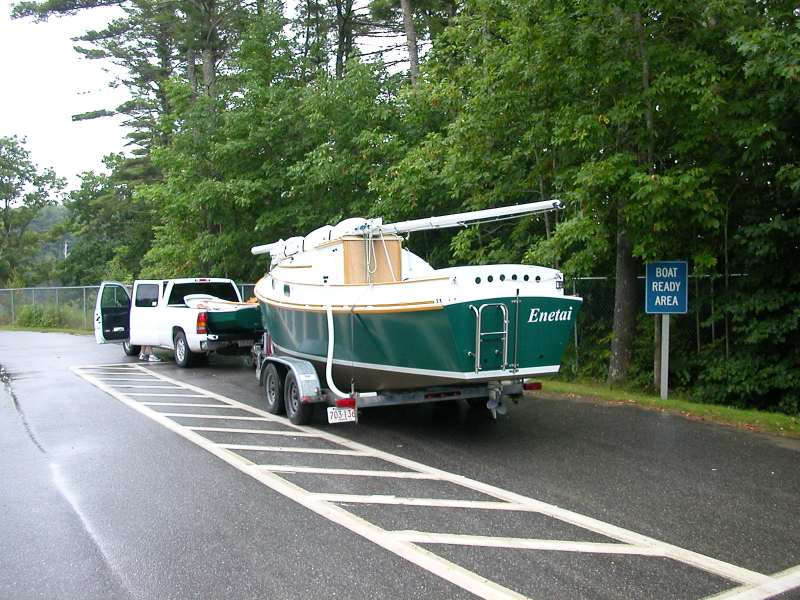
We had our trailer custom built by Triad Trailers of Danbury Connecticut. They specialize in sailboat trailers. They should have the design for NIS26 trailer on file. If you order from them be sure to specify galvanized frame, axles and hardware. For some reason they prefer to paint rather than galvanize. Looks better...as long as you never launch your boat in salt water. Also specify stainless steel brake lines.
Update 10 October 2012: It looks like Triad Trailers has moved to Charlotte North Carolina. Also, they are galvanizing all their trailers now.
Low, low, low! The trailer must get the boat low to the road for easy launch and retrieval. The trailer is 8.5' wide so the boat will fit between the wheels. I worked with Triad to lower the boat every possible inch. These efforts include:
- Dexter Torflex torsion axles. The "start angle" is the angle of the crank arm with no load. I specified a 10 degree up start angle which puts the spindles above the torsion tube. This limits the total range of motion but lowers the boat several inches, compared to a down start angle. The wheels swing up and forward on a bump so be sure the fenders will clear.
- 14 inch wheels rather than 15 inch wheels.
- The crossmembers of the frame are set as low as possible so the hull rests between the rails. The ones under the middle of the boat are set so there is just enough overlap with the rails for sufficient structural weld.
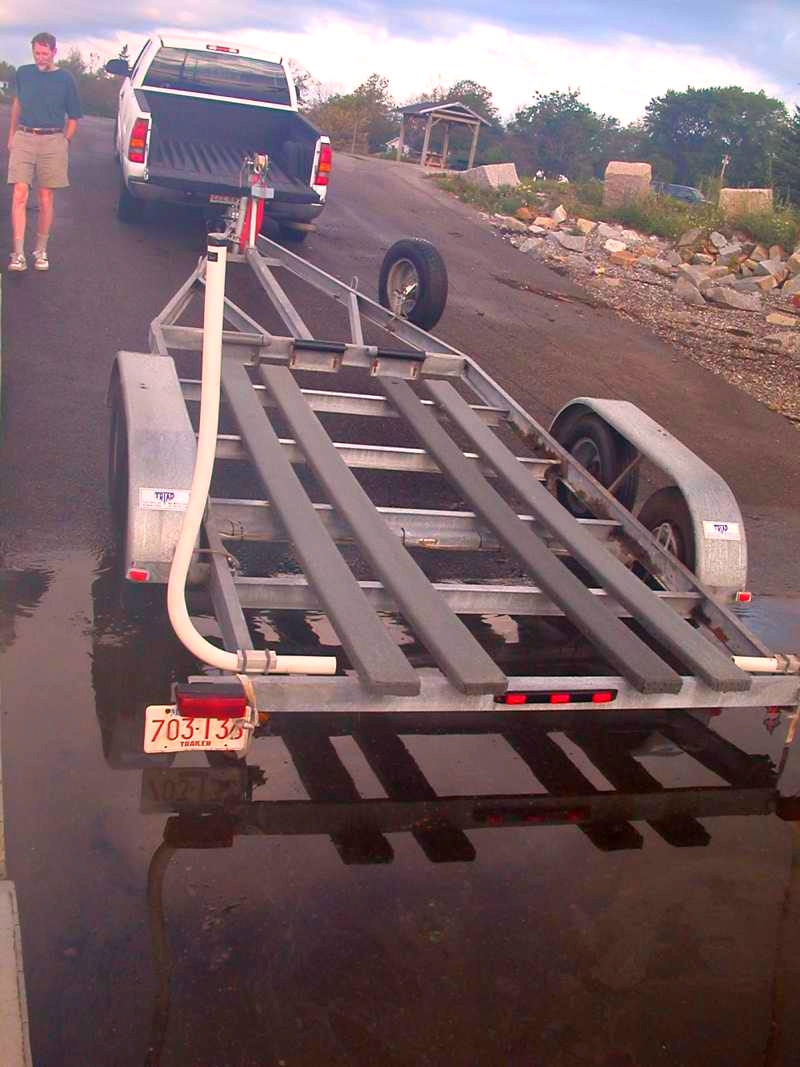
The picture is our trailer on the ramp in Rockland Maine. Great ramp in a great city!
The trailer has carpeted bunks with a row of rollers across the trailer at the forward end of the bunks. As the trailer is backed into the water, the stern of the boat floats up, so the boat rests on the rollers. A gentle tap of the brakes and the boat rolls easily off.

Our trailer came with a tongue extension but we have never used it. The back tires of the truck have never touched salt water. Usually I can stand at the winch without getting my feet wet. Maybe if we ever tried to launch off a beach we would need the tongue extension. We have only ever launched off paved ramps.
We have surge brakes on the rear axle. These have given me a lot of grief. The saltwater plays havoc with the drum brakes, even with galvanized shoes and stainless steel springs. I have completely replaced the drum brake wheel assemblies twice so far due to corrosion. Between complete replacements, I have also had to replace the wheel cylinders occasionally. I see disk brakes in our future. At least the problems will be different...
New in 2010, I replaced the drum brakes with Kodiak all-stainless disk brakes! Time will tell if this was a smart move. They sure cost a pretty penny! Check these babies out:
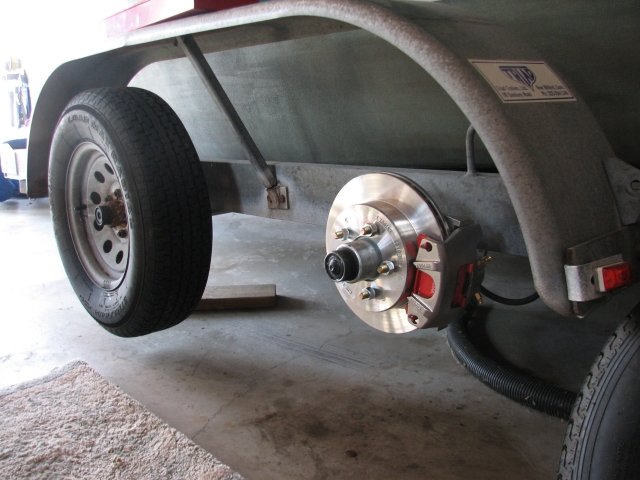
Update 10 October 2012: So far, the disk brakes have been trouble-free. The steel brake pads are beginning to rust a little but nothing alarming.
Update 22 March 2016: After five seasons, there is very little corrosion on the brake calipers and disks.

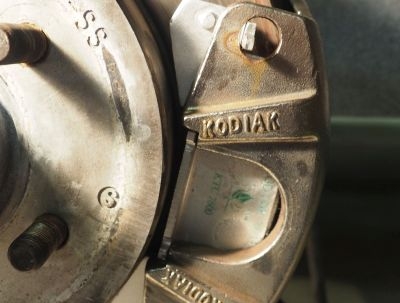
The pads are worn out, the linings mostly gone (left). The steel brake pad backings are severely rusted. I put in new pads from Kodiak with stainless steel backings (right). I should have replaced the pads last year.
We have put a lot of miles on the trailer since putting in the disk brakes but the wear seems excessive. Are they dragging? The hubs are usually warm when I check them but not hot. Maybe the trailer brakes are coming on too soon and braking the truck as well as the trailer.
Here are the old drum brakes. Good riddance! We recycled the them as scrap metal.
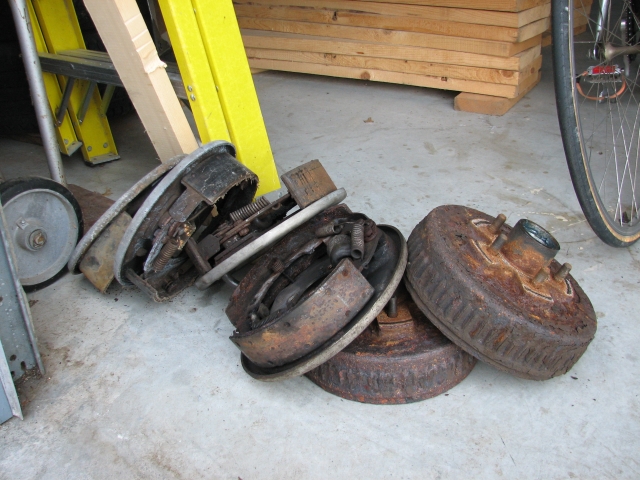
Tow vehicle: We've towed with a full size 1/2 ton 2-wheel-drive Chevy pickup. A 2001 model replaced our former 1991 model. They rust out around here before they wear out (we've had particular trouble with brake lines rusting out, but that's a whole other story). This Chevy has a 4.8 liter V8 which has plenty of power for all but the steepest hills. It has a limited slip differential which helps on slippery ramps. 4-wheel drive is not necessary on the paved ramps we use.
Our truck has an extended cab which gives a longer (better) wheel base and has room for our family of three plus impedimenta inside. The 9' dinghy fits in the 6.5' bed with the tailgate down.
Update 10 October 2012: We have moved on to a 2007 Ford F150 with the same basic specs as the Chevy except this one has a bigger engine and 4WD, neither of which have been necessary where we have gone.
This boat and trailer tow really well. There has never been a hint of sway and it seems to glide over potholes. I credit the torsion axle suspension and radial tires. The load is balanced to provide about 500 pounds of tongue weight.The boat extends well beyond the end of the trailer, which exaggerates motion in the back of the boat. We have trouble with things getting tossed around in the stern when we go over bumps. We leave the outboard motor down with the hoist cable slack. We used to leave it up but the bouncing was hard on the hoist cable. The rudder rides in the back of the truck. I have too much labor and care invested in the rudder to leave it on the back of the boat where it might be damaged. We have to take the rudder off to fit the boat in the garage, anyway.
We had an opportunity to weigh the rig at a truck stop while loaded for a cruise. The boat on trailer came in at 5500 lbs not including the tongue weight. That was about 1000 lbs more than I expected! Here are the weights compared to the weight limits for the truck and trailer.

I am not too worried about the axle limits because the axles were derated by the manufacturer from 3750lb each to 2500lb. (They used softer rubber rods in the torsion tubes.) We have had two blow-outs. Both were on the front axle. I realized that torsion axles do not share the load well and that the trailer frame needs to be level. I raised the hitch 4 inches and have not had any blow-outs since.
Trailer Advice:
- What I learned the hard way: Spindle-lube hubs have double lip seals, one to keep the grease in and one to keep the water out. Both lips need lubrication. On a brand new trailer with shiny new spindles,
if you put the hubs on dry and pump them full of grease, the first lip will seal really well,
keeping all the grease in the hub and not letting ANY of it into the space between the lips.
If you tow it this way, The second lip will wear out from running dry. If you then dip your new trailer in salt water, water will get in to the space between
the lips and pit the sealing surfaces. Forever after, you will have trouble with seal wear
and leaking. The next time I get a new trailer you can bet I will pull the hubs and make
sure there is grease between the lips of the seals. My advice, on a new trailer, or new axle, be sure the shop lubricates the seals before putting the hubs on!
Update 10 October 2012: I installed a "SKF Speedi-Sleeve" (#99171 for this axle) on the spindle with the most damage last spring, along with a new grease seal. So far it is working fine. The speedi-sleeve (Redi-Sleeve is another brand) is a very thin stainless steel sleeve that fits over the damaged spindle to provide a new sealing surface. It does not require changing the seal size.
Update 22 March 2016: I have now installed speedi-sleeves on all four spindles. I was not getting more than one or two seasons out of each grease seal on the damaged spindles. - Brake adjustment: The conventional wisdom is that you adjust drum brakes by tightening them until the wheel won't turn then back the adjustment off ten clicks. I have found that this is not enough. 15 clicks is better. There is a little more motion in the coupler but your brakes won't overheat in a traffic jam, blowing out the rubber plugs and spewing smoking grease in the road.... Been there.
- Bearing maintenance: I do not fuss with the hubs if there is no apparent problem. Each spring, I take a look around. I look for grease on the back of the rims, indicating a leaky seal. I spin each wheel and listen for rumbling bearings (haven't heard anything yet). I check that each brake actuates and releases. I pry the rubber plug out of each hub and look for milky or runny grease. If the grease looks and smells fresh, I put the plug back in and declare it ready for another season. I do not ever add grease during the season unless something bad has happened, such as a thermal event from a dragging brake. I have never had water get into the bearings, even with leaky seals.